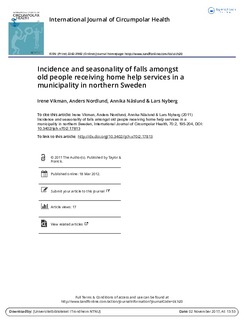| dc.contributor.author | Vikman, Irene | |
| dc.contributor.author | Nordlund, Anders | |
| dc.contributor.author | Näslund, Annika | |
| dc.contributor.author | Nyberg, Lars | |
| dc.date.accessioned | 2017-06-07T12:40:03Z | |
| dc.date.available | 2017-06-07T12:40:03Z | |
| dc.date.issued | 2011 | |
| dc.identifier.citation | Vikman, I., Nordlund, A., Näslund, A. & Nyberg, L. (2011) Incidence and seasonality of falls amongst old people receiving home help services in a municipality in northern Sweden. International Journal of Circumpolar Health (Online), 70(2). | |
| dc.identifier.issn | 2242-3982 | |
| dc.identifier.uri | http://hdl.handle.net/11250/2445125 | |
| dc.description | Artikkelen omhandler en studie hvor hensikten var å undersøke forekomst, inkludert variasjoner ad sesonger, omstendigheter og skader relatert til fall hos eldre som bor hjemme og mottar hjemmesykepleie, samt undersøke om det er en sammenheng mellom fall og type/omfang hjelp fra hjemmesykepleien. | |
| dc.description.abstract | Objectives: falls among old people is a well-documented phenomenon; however, falls among people living in the community and receiving home help services have been under-researched. The aim of this study was to investigate the incidence, including possible seasonal variation, circumstances and injuries related to falls among community living home help receivers, and to investigate whether fall incidence is associated with the type and amount of home help services received. Study design: Prospective cohort study. Methods: all 614 persons aged 65 and over who were living in a particular northern Swedish community and receiving municipality home help were included. Data on age, sex and home help service use were collected from home help service records, and falls were reported by staff on report forms specifically designed for the study. Results: a total number of 264 falls were recorded among 122 participants. The overall fall incidence was 626 per 1,000 PY, and incidence rate ratios were significantly correlated to the total amount of services used (p<0.001), as well as to the degree of help for I-ADL needs (p<0.001), P-ADL needs (p<0.001) and escort service (p=0.007). The proportion of falls reported as resulting in injury was 33 %. The monthly fall incidence was significantly associated to daylight photoperiod, however it was not associated to temperature. Conclusions: fall incidence among home help receivers aged 65 and over seems correlated to the amount of services they receive. This is probably explained by the fact that impairments connected to ADL limitations and home help needs also are connected to an increased risk of falls. This implies that fall prevention should be considered when planning home help care for old people with ADL limitations. Further research on the connection between daylight photoperiod and fall incidence in populations at different latitudes is needed. | |
| dc.language.iso | eng | |
| dc.rights | Navngivelse 4.0 Internasjonal | |
| dc.rights.uri | http://creativecommons.org/licenses/by/4.0/deed.no | |
| dc.title | Incidence and seasonality of falls amongst old people receiving home help services in a municipality in northern Sweden | |
| dc.type | Journal article | |
| dc.source.journal | International Journal of Circumpolar Health | |
| dc.identifier.doi | 10.3402/ijch.v70i2.17813 | |

